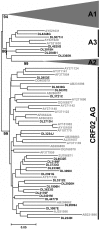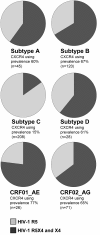Frequent CXCR4 tropism of HIV-1 subtype A and CRF02_AG during late-stage disease--indication of an evolving epidemic in West Africa
- PMID: 20307309
- PMCID: PMC2855529
- DOI: 10.1186/1742-4690-7-23
Frequent CXCR4 tropism of HIV-1 subtype A and CRF02_AG during late-stage disease--indication of an evolving epidemic in West Africa
Abstract
Background: HIV-1 is one of the fastest evolving pathogens, and is distinguished by geographic and genetic variants that have been classified into different subtypes and circulating recombinant forms (CRFs). Early in infection the primary coreceptor is CCR5, but during disease course CXCR4-using HIV-1 populations may emerge. This has been correlated with accelerated disease progression in HIV-1 subtype B. Basic knowledge of HIV-1 coreceptor tropism is important due to the recent introduction of coreceptor antagonists in antiretroviral therapy, and subtype-specific differences regarding how frequently HIV-1 CXCR4-using populations appear in late-stage disease need to be further investigated. To study how frequently CXCR4-using populations appear in late-stage disease among HIV-1 subtype A and CRF02_AG, we evaluated the accuracy of a recombinant virus phenotypic assay for these subtypes, and used it to determine the HIV-1 coreceptor tropism of plasma samples collected during late-stage disease in Guinea-Bissau. We also performed a genotypic analysis and investigated subtype-specific differences in the appearance of CXCR4 tropism late in disease.
Results: We found that the recombinant virus phenotypic assay accurately predicted HIV-1 coreceptor tropism of subtype A and CRF02_AG. Over the study period (1997-2007), we found an increasing and generally high frequency of CXCR4 tropism (86%) in CRF02_AG. By sequence analysis of the V3 region of our samples we developed a novel genotypic rule for predicting CXCR4 tropism in CRF02_AG, based on the combined criteria of the total number of charged amino acids and net charge. This rule had higher sensitivity than previously described genotypic rules and may be useful for development of future genotypic tools for this CRF. Finally, we conducted a literature analysis, combining data of 498 individuals in late-stage disease, and found high amounts of CXCR4 tropism for all major HIV-1 subtypes (60-77%), except for subtype C (15%).
Conclusions: The increase in CXCR4 tropism over time suggests an evolving epidemic of CRF02_AG. The results of the literature analysis demonstrate the need for further studies investigating subtype-specific emergence for CXCR4-tropism; this may be particularly important due to the introduction of CCR5-antagonists in HIV treatment regimens.
Figures


References
-
- Kaleebu P, Nankya IL, Yirrell DL, Shafer LA, Kyosiimire-Lugemwa J, Lule DB, Morgan D, Beddows S, Weber J, Whitworth JA. Relation between chemokine receptor use, disease stage, and HIV-1 subtypes A and D: results from a rural Ugandan cohort. J Acquir Immune Defic Syndr. 2007;45:28–33. doi: 10.1097/QAI.0b013e3180385aa0. - DOI - PubMed
-
- Asjo B, Morfeldt-Manson L, Albert J, Biberfeld G, Karlsson A, Lidman K, Fenyo EM. Replicative capacity of human immunodeficiency virus from patients with varying severity of HIV infection. Lancet. 1986;2:660–662. - PubMed
Publication types
MeSH terms
Substances
Associated data
- Actions
- Actions
- Actions
- Actions
- Actions
- Actions
- Actions
- Actions
- Actions
- Actions
- Actions
- Actions
- Actions
- Actions
- Actions
- Actions
- Actions
- Actions
- Actions
- Actions
- Actions
- Actions
- Actions
- Actions
- Actions
- Actions
- Actions
- Actions
- Actions
- Actions
- Actions
- Actions
- Actions
- Actions
- Actions
- Actions
LinkOut - more resources
Full Text Sources
Medical
Molecular Biology Databases

